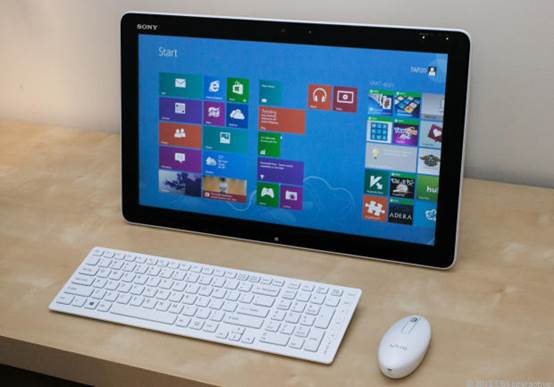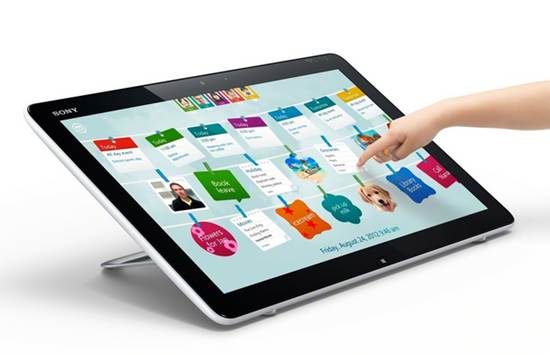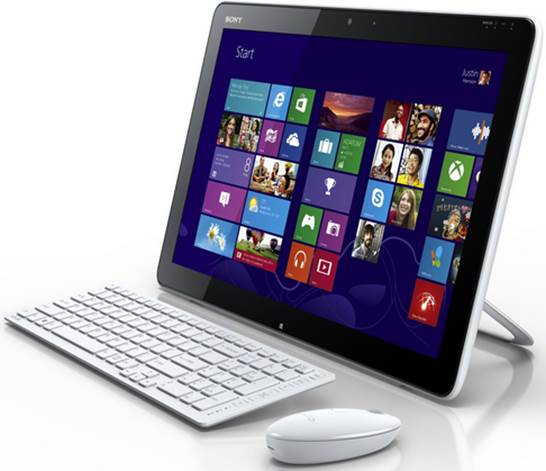Sony markets its Vaio Tap 20 as a mobile
desktop, but you could say that about any portable computer. We think
“laptablet” is closer to the mark. With its 20-inch display, the Tap 20 is both
an oversize laptop and a gargantuan tablet. And it wouldn’t make any sense
atall without Windows 8.
Yes, Windows 8 is the operating system PC
enthusiasts love to hate, but this machine is proof that Microsoft’s strategy
of melding the desktop and mobile experiences can work. The Tap 20 isn’t
perfect by a long shot, but it’s pretty darn cool. We challenge you to spend a
few minutes with it and not find yourself grinning like a fool in love. And if
you pass that test, fire up one of the free pinball games Sony throws in,
orient the device in portrait mode, and stroke the screen to pull back the
plunger.

Sony
Vaio Tap 20 Mobile Desktop
The model we tested was outfitted with a
1.7GHz Intel Core i5-3317U mobile processor, but only 4GB of DDR3/1600 memory.
Considering the price of memory, and this machine’s occasionally sluggish
performance, we think Sony should have doubled it. If you decide to buy one,
we’d recommend spending the extra $200 to buy the next model up, which does
just that. That model also has a 1.9GHz Intel Core i7 proc and a larger hard
drive (1TB versus the 750GB in the model sent for this review; both drives are
5,400rpm spinners).
The Tap 20 features a 20-inch LED-backlit
IPS display with 10 touch points, natch which is essential when you consider
all the angles at which you might end up using it. The 1600x900 touchscreen is
very responsive, as we discovered when playing the aforementioned pinball
games. And while the integrated graphics aren’t strong enough for playing
A-level games, they did a fine job with the more casual variety. We were
particularly impressed with the speed at which we were able to operate the
flippers. We were thinking it would be even more fun if the games’ physics
responded to tilting, but that might have resulted in a little too much
reality: It would require holding the device stock still and perfectly level.

The 1600x900 touchscreen is very responsive, as we discovered when playing
the aforementioned pinball games.
You can use the folding stand on the back
of the display to position it at an infinite number of angles for reading, or
you can fold it completely flat and use the tablet horizontally. The stand does
double-duty as a handle when you want to take the device into another room (did
we mention it can run on battery power? It lasted three hours in our test). But
we wish the handle was a wee bit thicker, had more-rounded edges, or was
padded, because we could feel every ounce of the Tap 20’s 11.46-pounds digging
into the backs of our fingers as we lugged it around. It’s also a little
awkward to set up, because natural movement would have you lay it down flat on
its screen and if you have kids, you know they’re going to do just that. It
takes two hands to flip it around and stand it up on its easel.

Sony
gives you a wireless mouse and keyboard, but who needs them?
The speakers mounted on the back of the
display are borderline terrible, but that’s typical of even all-in-one desktop
PCs. Do yourself a favor and plug in headphones. Speaking of all-in-ones, the
Tap 20 could fill that role, too. Its biggest shortcoming is the lack of an
HDMI input although that’s really more of a missed opportunity than a
deal-breaker.
There’s nothing else remotely like the Vaio
Tap 20, and we applaud Sony’s audacity for bringing it to market. Priced at a
cool grand, this machine is hardly an impulse buy; but it reminds us why we
love computers so much.
|
Specifications
§ CPU:
1.7GHz Intel Core i5-3317U
§ GPU:
Integrated Intel HD Graphics ; 4000
§ RAM:
4GB DDR3/1600
§ Display:
20-inch, 1600x900
§ Storage:
Toshiba Travelstar 5K750 i 750GB, 5,400rpm
§ Connectivity:
2x USB 3.0, memory card reader, headphone, mic, webcam, 802.11 b/g/n,
Bluetooth, NFC, gigabit Ethernet
§ Lap:
11 lbs, 4.6 oz
|